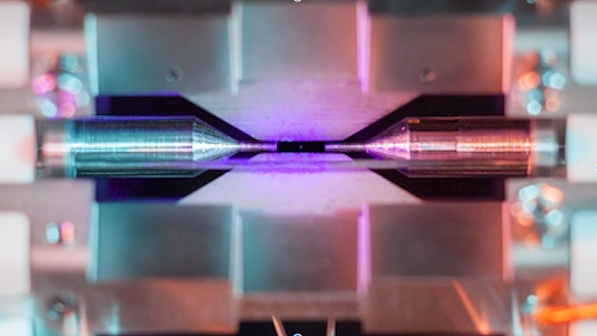
Updated | A graduate student has captured a photograph of a single atom suspended in an ion trap. The image, taken with an ordinary camera, has won a national science photography prize.
David Nadlinger, who attends the University of Oxford, won the competition organized by the U.K.'s Engineering and Physical Sciences Research Council (EPSRC).

Taken through the window of an ultra-high vacuum chamber, you can see the atom as a pinprick of light between two metal needles. The gap between these needles is less than 0.08 of an inch.
Metal electrodes produce fields that trap the single atom in place. The atom absorbed and re-emitted blue-violet light from a laser fast enough for Nadlinger to take his breathtaking long-exposure shot.
Nadlinger said in a statement: "The idea of being able to see a single atom with the naked eye had struck me as a wonderfully direct and visceral bridge between the miniscule quantum world and our macroscopic reality. A back-of-the-envelope calculation showed the numbers to be on my side, and when I set off to the lab with camera and tripods one quiet Sunday afternoon, I was rewarded with this particular picture of a small, pale blue dot."
Nadlinger cages atoms like this for his research. Laser-cooled atomic ions are used to help scientists understand the strange and mysterious world of quantum physics. At present, they produce extremely accurate clocks and sensors. In the future they will be the foundation of super-powerful quantum computers.
He told Gizmodo: "It's exciting to find a picture that resonates with other people that shows what I spend my days and nights working on."
Other spectacular winning photographs
Judges chose Nadlinger's image from more than 100 photographs submitted to the competition. Dame Anne Dowling, Royal Academy of Engineering president and one of the judges, said in the statement: "Not only do we have really strong, attractive photographs, the stories behind them about the research and why it is being done are inspiring."
"Single Atom in an Ion Trap" won first prize in the Equipment & Facilities category, and was crowned the overall competition winner. The other categories were Eureka & Discovery, People & Skills, Innovation, and Weird & Wonderful.
Li Shen from Imperial College London won first place in the Eureka and Discovery category for his image of fluid instability patterns on a bubble of soap.

Bernice Akpinar, also of Imperial College London, came first in the Weird and Wonderful Category for an image of the "nanosized net" structures that give butterfly wings their dazzle.

A tiny drug-coated bubble won the Innovation category. Estelle Beguin, also from the University of Oxford, captured the image of a microbubble drug delivery system.

A man wearing an electroencephalography (EEG) device was the winning People & Skills image, from Richard Coyne of the University of Edinburgh. The picture documents researchers' use of EEG to gauge the response of elderly brains to different outdoor environments.

Ellie Cosgrave, one of the competition judges and a BBC broadcaster, said in the statement: "The winners we have selected demonstrate how science and technology is affecting people's lives today at many different physical scales. We have examples from the nanoscale, how our cells are working; how our immune systems might be able to treat different types of diseases; all the way up to technologies that can help us move through cities."
This article has been updated to include comment from Dame Ann Dowling.
Uncommon Knowledge
Newsweek is committed to challenging conventional wisdom and finding connections in the search for common ground.
Newsweek is committed to challenging conventional wisdom and finding connections in the search for common ground.
About the writer
Katherine Hignett is a reporter based in London. She currently covers current affairs, health and science. Prior to joining Newsweek ... Read more





